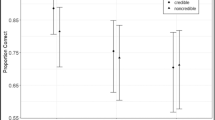Abstract
Thirty-two preschool children were questioned after viewing four short films. The form of the question (affirmative-negative, definite-indefinite article, some-any quantifier) was systematically varied in a counterbalanced design. The form of the question did not significantly affect answers to questions about entities actually present in the films; however, it did have significant effects on answers concerning entities which were not in the film. Questions such as “Did you see the...,” “Did you see any...,” and “Didn't you see some...” were answered yes more frequently than other question types. Thus young children are aware of the expectation conveyed by certain linguistic forms, such asthe. The results are discussed in the light of current models of constructive memory as well as their implications for accurate questioning of children.
Similar content being viewed by others
References
Bolinger, D. L. (1957).Interrogative Structures of American English, American Dialect Society, University of Alabama Press, University, Alabama.
Bolinger, D. L. (1960). Linguistic science and linguistic engineering.Word 16:374–391.
Brown, M. R. 1926).Legal Psychology, Bobbs-Merrill, Indianapolis.
Lipmann, O. (1911). Pedagogical psychology of report.J. Educ. Psychol. 2:253–261.
Livant, W. P. (n.d.). Sentences without kernels: A study of a family of questions. Unpublished manuscript.
Loftus, E. G., and Palmer, J. C. (1974). Reconstruction of automobile destruction: An example of the interaction between language and memory.J. Verb. Learn. Verb. Behav. 13:585–589.
Loftus, E. G., and Zanni, G. (1975). Eyewitness testimony: The influence of the wording of a question.Bull. Psychonom. Soc. 5:86–88.
Maratsos, M. P. (1974). Preschool children's use of definite and indefinite articles.Child Dev. 45:446–455.
McCarty, D. G. (1929).Psychology for the Lawyer, Prentice-Hall, New York.
Muscio, B. (1915). The influence of the form of the question.Br. J. Psychol. 8:351–389.
Rouke, F. L. (1957). Psychological research on problems of testimony.J. Soc. Issues 13:50–59.
Supreme Court Reporter (1973).Rules of evidence for United States and Courts and Magistrates, Vol. 3.
Varendonck, J. (1911). Les temoignages d'enfants dans un proces retentissant.Arch. Psychol. 11:129–171.
Whipple, G. M. (1909). The observer as reporter: A survey of the psychology of testimony.Psychol. Bull. 6:153–170.
Whipple, G. M. (1911). Psychology of testimony and report.Psychol. Bull. 8:307–310.
Whipple, G. M. (1913). Review of Les Temoignages d'enfants dans un proces retentissant, by J. Varendonck.J. Crim. Law Criminol. 4:150–154.
Author information
Authors and Affiliations
Additional information
An earlier version of this article was delivered to the Stanford Child Language Research Forum, Stanford University, April 1976.
Rights and permissions
About this article
Cite this article
Dale, P.S., Loftus, E.F. & Rathbun, L. The influence of the form of the question on the eyewitness testimony of preschool children. J Psycholinguist Res 7, 269–277 (1978). https://doi.org/10.1007/BF01068110
Received:
Issue Date:
DOI: https://doi.org/10.1007/BF01068110




